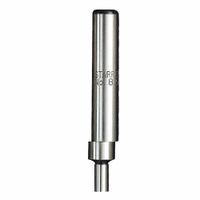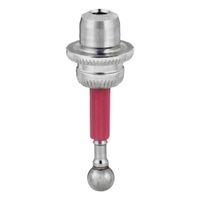Call +(254) 703 030 000 / 751 483 999 / 721 704 777
- Home
- Machining
- Precision Measuring Tools
- Setup Layout Alignment Tools
- Edge Center Finders Accessories
.....Read More
Frequently Asked Questions
What is the purpose of an edge finder in machining?
An edge finder is a precision tool used in machining to accurately locate the edges, center points, or other features of a workpiece. Its primary purpose is to establish a reference point for subsequent machining operations, ensuring precision and accuracy in the manufacturing process.
The edge finder typically consists of a shank and a rotating tip. When the machine spindle rotates the edge finder, the operator moves the workpiece towards the tool. As the edge of the workpiece contacts the rotating tip, the tip shifts laterally, indicating the exact position of the edge. This allows the machinist to set the machine's digital readout or manual dials to zero, establishing a precise datum point for further operations.
Using an edge finder is crucial for several reasons:
1. **Accuracy**: It provides a high level of precision, often within a few thousandths of an inch, which is essential for tight tolerance machining.
2. **Efficiency**: By quickly and accurately locating edges, it reduces setup time and increases productivity.
3. **Versatility**: Edge finders can be used on various materials and with different types of machines, including mills and CNC machines.
4. **Error Reduction**: It minimizes human error in manual measurements, leading to more consistent and reliable machining outcomes.
5. **Cost-Effectiveness**: By improving accuracy and reducing waste, it contributes to cost savings in the manufacturing process.
In summary, an edge finder is a vital tool in machining that enhances precision, efficiency, and reliability, ensuring that subsequent machining operations are based on accurate reference points.
How do you use a center finder on a milling machine?
To use a center finder on a milling machine, follow these steps:
1. **Select the Center Finder**: Choose a suitable center finder for your task, such as a wiggler, edge finder, or electronic center finder.
2. **Install the Center Finder**: Securely mount the center finder in the milling machine's spindle or chuck.
3. **Prepare the Workpiece**: Ensure the workpiece is properly secured on the milling machine table using clamps or a vise.
4. **Align the Machine**: Turn on the milling machine and set the spindle speed to a low RPM to avoid damaging the center finder.
5. **Position the Center Finder**: Move the milling table to bring the center finder close to the edge or feature you want to locate.
6. **Engage the Center Finder**: For a wiggler or edge finder, slowly move the table until the center finder makes contact with the workpiece. The wiggler will visibly "kick" or the edge finder will "jump" when it touches the edge.
7. **Zero the Machine**: Once contact is made, zero the machine's digital readout (DRO) or note the dial indicator reading. This establishes a reference point.
8. **Calculate the Center**: If finding the center of a hole or feature, move the table half the diameter of the center finder to align the spindle with the center.
9. **Verify Alignment**: Double-check the alignment by repeating the process from another direction if necessary.
10. **Proceed with Machining**: With the center accurately located, proceed with the milling operation as planned.
By following these steps, you can accurately locate the center of a workpiece or feature on a milling machine, ensuring precision in your machining tasks.
What are the differences between edge finders and center finders?
Edge finders and center finders are precision tools used in machining to locate specific points on a workpiece, but they serve different purposes and operate differently.
Edge Finders:
1. Purpose: Edge finders are used to locate the exact edge of a workpiece. This is crucial for setting up a machine tool to ensure accurate machining operations.
2. Operation: Typically, an edge finder has a cylindrical shank and a spring-loaded tip. When the rotating edge finder makes contact with the workpiece, the tip shifts, indicating the edge's position.
3. Types: Common types include mechanical edge finders and electronic edge finders. Mechanical ones rely on physical contact, while electronic ones use electrical conductivity to detect edges.
4. Accuracy: Edge finders are highly accurate, often within 0.0005 inches, making them suitable for precision work.
Center Finders:
1. Purpose: Center finders are used to locate the center of a workpiece, such as the center of a hole or a cylindrical object. This is essential for operations like drilling or turning.
2. Operation: Center finders can be optical, mechanical, or electronic. Optical center finders use lenses to visually align the tool with the workpiece center. Mechanical ones use a pointed tip that aligns with the center, while electronic versions use sensors.
3. Types: Optical center finders provide a visual method for alignment, while mechanical and electronic types offer tactile or digital feedback.
4. Accuracy: Center finders are also precise, but their accuracy depends on the type and method used, generally within a few thousandths of an inch.
In summary, edge finders are primarily for locating edges, while center finders are for finding centers. Both are essential for ensuring precision in machining tasks.
How do 3D edge and center finders work?
3D edge and center finders are precision tools used in machining to locate the edges, centers, and surfaces of a workpiece. They ensure accurate alignment of the tool with the workpiece, crucial for precision machining.
**3D Edge Finder:**
A 3D edge finder typically consists of a probe and a body. The probe is spring-loaded and can move in three dimensions. When the spindle rotates, the probe is brought into contact with the workpiece. As it touches the edge, the probe deflects, and the machine's readout indicates the exact position. The deflection is often visible or can be detected electronically, allowing the operator to determine the precise edge location. This tool can find edges along the X, Y, and Z axes, hence the "3D" designation.
**Center Finder:**
Center finders are used to locate the center of a hole or a cylindrical workpiece. They often have a conical or spherical tip that fits into the hole or against the cylindrical surface. When the spindle rotates, the center finder aligns itself with the center of the hole or the axis of the cylinder. The operator can then read the machine's position to determine the exact center. Some center finders use electronic sensors to provide a digital readout of the center position.
Both tools are essential for setting up workpieces accurately in CNC machines or manual mills. They reduce setup time and improve machining accuracy by ensuring that the tool path is correctly aligned with the workpiece features.
What are the benefits of using a digital edge finder?
A digital edge finder offers several benefits in precision machining and manufacturing:
1. **Accuracy**: Digital edge finders provide high precision in locating the edges of a workpiece, ensuring accurate measurements and reducing errors in machining processes.
2. **Ease of Use**: They are user-friendly, often featuring digital displays that make it easy to read measurements without requiring manual interpretation, unlike traditional mechanical edge finders.
3. **Speed**: Digital edge finders can quickly locate edges, saving time in setup and increasing overall efficiency in the machining process.
4. **Versatility**: They can be used on various materials and surfaces, including conductive and non-conductive materials, making them suitable for a wide range of applications.
5. **Repeatability**: Digital edge finders offer consistent results, which is crucial for tasks that require repeated measurements and setups, ensuring uniformity across multiple parts.
6. **Reduced Human Error**: The digital readout minimizes the risk of human error associated with reading scales or dials, leading to more reliable outcomes.
7. **Enhanced Visibility**: The digital display is often backlit, providing clear visibility in different lighting conditions, which is beneficial in poorly lit environments.
8. **Integration with CNC Machines**: Many digital edge finders can be easily integrated with CNC machines, allowing for automated processes and further enhancing precision and efficiency.
9. **Durability**: They are typically robust and designed to withstand the rigors of industrial environments, offering long-term reliability.
10. **Cost-Effectiveness**: While the initial investment may be higher than traditional edge finders, the increased accuracy, efficiency, and reduced waste can lead to cost savings over time.
Overall, digital edge finders enhance the quality and efficiency of machining operations, making them a valuable tool in modern manufacturing.
How do you replace the tips on an indicating edge finder?
1. **Safety First**: Ensure the machine is turned off and the edge finder is removed from the spindle or tool holder.
2. **Secure the Edge Finder**: Place the edge finder in a vise or hold it securely to prevent it from moving during the replacement process.
3. **Remove the Old Tip**: Gently unscrew the old tip by hand. If it is tight, use a small wrench or pliers, taking care not to damage the edge finder body.
4. **Inspect the New Tip**: Check the new tip for any defects or debris. Ensure it is clean and free from any manufacturing residues.
5. **Install the New Tip**: Align the threads of the new tip with the edge finder body and screw it in by hand. Ensure it is snug but do not overtighten, as this can damage the threads.
6. **Check Alignment**: Once the new tip is installed, check its alignment by rotating the edge finder. The tip should spin concentrically without wobbling.
7. **Test the Edge Finder**: Reinstall the edge finder in the machine spindle or tool holder. Perform a test run to ensure the new tip functions correctly and the edge finder operates smoothly.
8. **Final Inspection**: After testing, inspect the edge finder and tip for any signs of improper installation or damage.
9. **Maintenance**: Regularly clean and inspect the edge finder and its tips to ensure longevity and accuracy. Store the edge finder in a protective case when not in use to prevent damage.
By following these steps, you can effectively replace the tips on an indicating edge finder, ensuring accurate and reliable performance.
What are the best practices for maintaining edge and center finders?
1. **Regular Cleaning**: After each use, clean the edge and center finders with a soft cloth to remove any debris, oil, or coolant. This prevents buildup that can affect accuracy.
2. **Proper Storage**: Store finders in a protective case or a designated tool holder to prevent damage. Ensure they are kept in a dry environment to avoid rust.
3. **Lubrication**: Apply a light coat of machine oil to prevent rust and ensure smooth operation. Avoid over-lubrication, which can attract dust and debris.
4. **Calibration**: Regularly check and calibrate the finders to ensure accuracy. Use a known reference to verify their precision and adjust as necessary.
5. **Handle with Care**: Avoid dropping or subjecting the finders to impact, as this can misalign or damage the tool.
6. **Avoid Excessive Force**: When using the finders, apply only the necessary amount of force. Excessive pressure can cause wear or damage.
7. **Inspect for Wear**: Regularly inspect the finders for signs of wear or damage, such as nicks or scratches, which can affect performance.
8. **Use Correctly**: Follow the manufacturer's instructions for use to avoid misuse that can lead to damage or inaccurate readings.
9. **Avoid Contamination**: Keep the finders away from corrosive substances and ensure they are not exposed to extreme temperatures.
10. **Professional Servicing**: If the finders are damaged or not functioning correctly, have them serviced by a professional rather than attempting repairs yourself.


